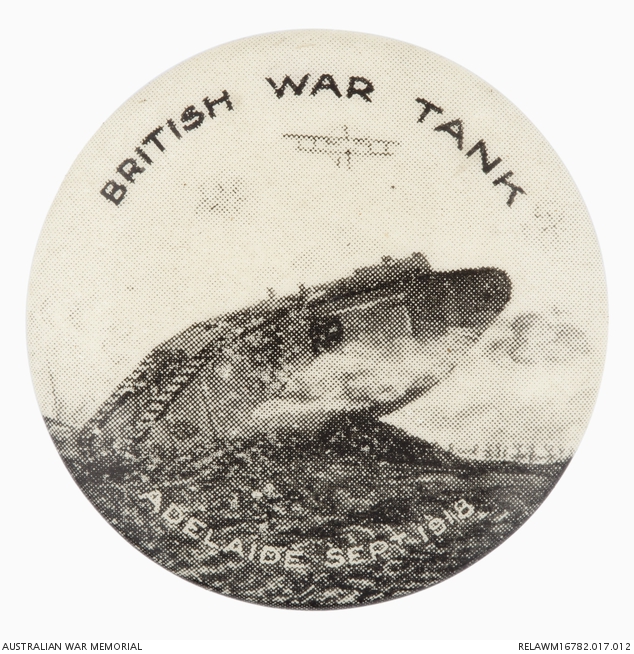Grit the Monster
Mk IV Female Tank (4643) made in Glasgow, Scotland, by Coventry Works in 1917. Female tanks were fitted with four machine guns, while Male versions carried 6 pounder guns.
Built to crash, smash and traverse with ease the potholed moonscape of the Western Front, British tanks were hailed by some as the answer to the stalemate of trench warfare. The rhomboidal shape lent itself to smashing through man-made obstacles, barbed wire fences and crossing wide trenches. Weighing 28 tons and carrying a crew of eight, the British Mark IV Female heavy was a frightening sight of thick steel cloaked in exhaust smoke.
Although only travelling at a maximum walking pace of around 6km per hour, British tanks evoked fear and terror amongst soldiers of the German Army. During the First Battle of Bullecourt, France, in April 1917 British Mark I and Mark II tanks were used for the first time in a coordinated attack with the Australian 4th Division. Although most of the tanks broke down and failed to reach their targets, Bean’s Official History records the demoralising effect they had on the German Army’s 123rd Infantry Regiment. German reports recalled,
Here for the first time our grenadiers encountered one of these famous monsters… It would be untrue to attempt to deny that the slowly advancing tank, which there was apparently no means of stopping, had a strong moral effect and succeeded in crippling the resistance.
Over time, German attitudes to the tanks changed as they developed methods of destroying them.
Rallying for the Monster
The “famous monsters” of the battlefront found favour with the Australian public. The Memorial’s Mark IV Female tank (serial number 4643) was shipped directly to Australia from the Coventry workshops in Glasgow and arrived in June 1918. From September it was the central feature of War Loan rallies in Adelaide, Melbourne and Sydney. As a fundraising tool it travelled around Australia and thrilled audiences with practical demonstrations that included climbing steep mounds, navigating out of deep holes, and crashing through thick brick walls, fences, and purpose-built structures.
The Mark IV Female Tank giving a demonstration in front of a crowd in 1918.
In Adelaide in September 1918, the Female Tank captivated the imaginations of onlookers with its climbing ability and sheer strength. Its size, unusual shape and low design also impressed upon audiences its monster-like qualities. South Australia’s The Advertiser on 6 September 1918 reported on its opening demonstration at Unley Oval: ‘the engines had been set buzzing rhythmically and the monster glided backwards and forwards a few times, nearly pushing down the fence of the oval before it got into position… It is an immense creature, more ponderous than an elephant, but low to the ground like a tortoise, and very broad in the beam... like toads of vast size emerging from the primeval slime in the twilight of the world’s dawn’.
Sydney audiences enamoured with the Female tank could pay for a closer inspection for £5.5s, whereas to ride in the monster cost double the fee. Small fundraising buttons featuring the 4643 tank were sold to further raise money.
Fundraising badge: Patriotic ‘British War Tank – Adelaide Sept 1918’ with MK IV female tank, 4643.
During the Adelaide demonstrations at Unley Oval a naming competition was held and on 14 September ‘the monster’ was christened “Grit” by Lady Galway, the wife of the South Australian governor. On Monday 16 September, The Register in Adelaide recorded the general response to the naming by those in attendance: "Applause followed the announcement of the name, because its unchallengeable appropriateness appealed to all. It revels in grit and dirt".
The naming ceremony was promptly followed by another demonstration during which,
...she showed the people the right way to treat German-headquarters. The machine opened out her engines and caused the substantial stone building to crumple up like tissue paper. A roar of laughter went round the ring, and general regret was expressed that there were no German officers inside of headquarters.
The Female Tank gave the Australian public the chance to imagine what it might be like to experience war in a tank, and offered a tangible connection to the battlefront.
Further reading
David Fletcher, The British Tanks 1915-19 (The Crowood Press, 2001).
A J Smithers, A New Exacalibur: The Development of the Tank 1909-1939 (Butler & Tanner, 1986).
Charles Bean, Official History of Australia in the War 1914-1918: Volume IV The Australian Imperial Force in France, 1917 (Angus & Robertson, 1935).
David Fletcher, British Mark I Tank 1916, (Osprey Publishing, 2004).
David Fletcher, British Mark IV Tank, (Osprey Publishing, 2007).



